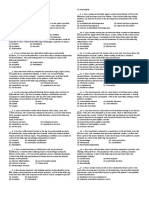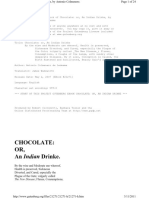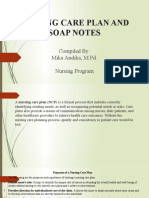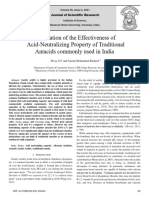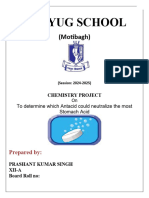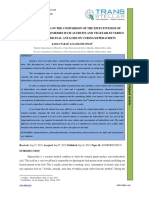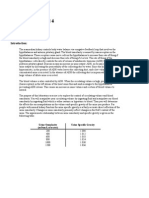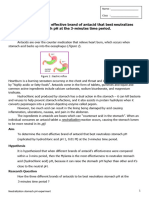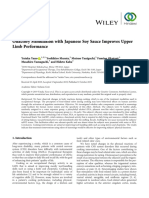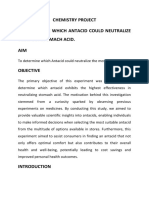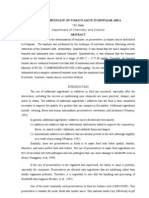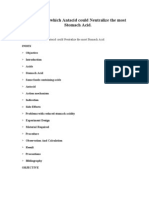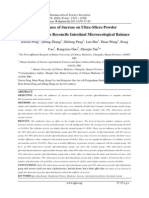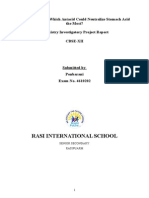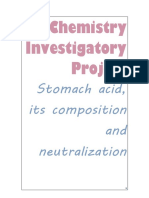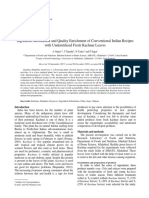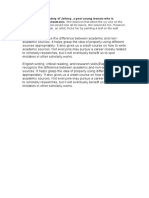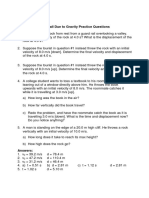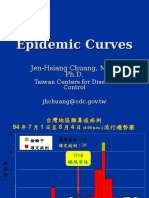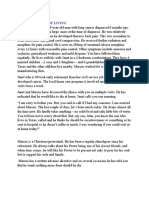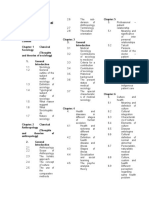Yukot, Chung
Yukot, Chung
Uploaded by
Cath DetoperezCopyright:
Available Formats
Yukot, Chung
Yukot, Chung
Uploaded by
Cath DetoperezOriginal Title
Copyright
Available Formats
Share this document
Did you find this document useful?
Is this content inappropriate?
Copyright:
Available Formats
Yukot, Chung
Yukot, Chung
Uploaded by
Cath DetoperezCopyright:
Available Formats
1
Comparing the effectiveness of non-synthetic remedies to commercially produced antacids
in combating acid reflux
Stanley Chung, Malalay Habib, Stanford Lin, Sabrina Ouyang
ABSTRACT
Acid reflux is a result of the backflow of digestive acid into the esophagus, causing
discomfort and sensations of heartburn (Badillo & Francis, 2014; Schneider et al., 2010).
Antacids offer temporary relief from the pain caused by acid reflux. While commercially
produced antacids have been in production since the early twentieth century, concerns about their
production and potential side effects have led to the widespread use of home remedies made
from varying non-synthetic materials (Bierer, 1990). In this study, the effectiveness of seven
different non-synthetic materials in increasing the pH of white vinegar, which simulated stomach
acid, was tested. The effectiveness of the home remedies was compared to that of commercially
produced antacids. The results were analyzed using a one-way ANOVA test and gave a p-value
of 0.0068, therefore rejecting the null hypothesis. A post-hoc Tukey’s multiple comparison test
was performed to determine where the significant differences were found in our results.
Altogether, these results indicated that commercially produced antacids, specifically TUMS®,
are more effective at neutralizing acid. Our findings provide a statistical perspective on the
comparison between commercially produced medicine and home remedies for acid reflux,
informing consumer decisions regarding the use of non-traditional medicine.
INTRODUCTION
Acid reflux is one of the characterizing symptoms of gastroesophageal reflux disease
(GERD), perhaps the most prevalent condition detected by gastroenterologists (Katz et al.,
2013). While GERD is a chronic condition manifesting through acid regurgitation and heartburn,
acid reflux, in particular, is primarily caused by transient lower esophageal sphincter relaxations
(TLESR), relaxations in the lower esophageal sphincter that take place independently of
swallowing (Badillo & Francis, 2014; Schneider et al., 2010; Zhang et al., 2002). Complications
with the lower esophageal sphincter, which is located between the esophagus and the stomach,
underlies the backflow of digestive acid into the esophagus. Commercially produced antacids
work by neutralizing gastric acid that has flowed into the esophagus and any excess gastric acid
in the stomach (Jakaria et al., 2015). While well-known brands such as TUMS®, Pepto-
Bismol®, and Gaviscon® produce medications that temporarily subside the pain caused by acid
reflux, many people turn to their homes to find alternative solutions.
Our non-synthetic samples are examples of suggested home remedies, which are simple
means of recovery for minor health problems (Parisius et al., 2014). Home remedies for ailments
permeate the internet, offering cost-reducing and natural alternatives to commercially produced
prescriptions. While the use of home remedies for the management of symptoms is not widely
researched and often anecdotal, it is commonplace among laypeople (Parisius et al., 2014).
Through our study, we aim to find whether these widely suggested home remedies for acid reflux
satisfy the claims made about them.
The aim of our experiment is to find out whether home remedies are able to neutralize
gastric acid and combat acid reflux, and if they work, how they compare to commercialized
antacids. If non-synthetic solutions are as effective at countering acid reflux as commercially
produced selections, then a resulting neutralized pH of 7.0 should be observed because antacids
should bring the pH level of gastric acid to the normal esophageal pH level of about 7.0 (Tutuian
& Castell, 2006). Our null hypothesis states that there is no significant difference between the
non-synthetic materials and commercially produced antacids in their capability to increase the
pH of the simulated stomach acid. Our alternative hypothesis states that there will be a
significant difference between the home remedies and store-bought antacids.
We predict that while the non-synthetic ingredients will be able to increase the pH of our
solution, the commercially produced antacids will be more effective and neutralize the solution
to a greater degree. Understanding the efficacy of these home remedies is important as
inadequate treatment for reflux disease can result in worsening conditions and complications in
the esophagus (Badillo & Francis, 2014). In more extreme cases, such as GERD, untreated
conditions can lead to pulmonary disease and esophageal cancer (Badillo & Francis, 2014; Mirić
et al., 2014). Overall, relief from these symptoms can greatly improve the quality of life.
METHODS
For this experiment, a simulation of the conditions of a human stomach was attempted.
To do so, 33 separate clear plastic cups were filled with 100 mL of white vinegar each. Each cup
was labeled with the test ingredient with 3 replicates for each of the 7 non-synthetic remedy
ingredients (ginger, spinach, almond milk, papaya, banana, vanilla yogurt, and aloe vera), 3
drugstore antacids [sodium alginate (SA, commonly known as Gaviscon), bismuth subsalicylate
(BSL, commonly known as Pepto Bismol), and TUMS® tablet], and 1 control of just white
vinegar, for a total of 33 labels. The next step was to prepare the ingredients before putting them
into their cups. In terms of preparation, the ginger, spinach, papaya, banana, aloe vera, and
TUMS® tablets needed to be modified for this experiment. For ginger, the root was cut into
slices, and for spinach, the leaves were chopped up, before being placed in boiling water to make
a tea mixture and then left to settle. In terms of the banana and papaya, they were cut up into
small pieces before being mashed up into their own aqueous solutions. For the aloe vera, the
plant was cut up and the juices and pieces were scraped straight off the plant and into a small
container and set aside. For the TUMS® tablets, the tablets were completely crushed up and the
three proportions were set aside.
After the two tea mixtures settled, everything was ready to be placed in their cups. For
the following solutions, ¼ of a cup was poured into their respective cups: ginger, spinach,
almond milk, papaya, and aloe vera. For the commercially produced antacids, the recommended
doses were put in each cup, which was 2 tablespoons for bismuth subsalicylate, 2 crushed up
tablets for TUMS®, and 15 mL for sodium alginate. For yogurt, the full container (15 mL) was
used for each cup. Finally, for the banana, the aqueous solution was split into 3 portions (25mL)
and poured into the cup. Each of these cups was then left to rest for 30 minutes (Figure 1).
Figure 1. The experimental setup, with 3 replicates of each test ingredient placed in white
vinegar. Each cup was labelled with the test ingredient and replicate number. All the ingredients
were left in the cups for 30 minutes after mixing with white vinegar.
Figure 2. On the left, the pH test strips used for each sample were displayed after all pH levels
were measured. The test strips lost their colour over time so the image does not reflect the
colours that were used to determine the pH. On the right, an example of comparing a pH test
strip to the provided colour chart immediately after dipping the test strip into the solution.
After 30 minutes, each cup was stirred thoroughly before the pH of each solution was
measured. The stir stick was washed, or a new stir stick was used each time a cup was stirred to
avoid cross-contamination. To determine the pH of each solution, a pH strip was dipped into the
solution and the colour of the pH strip was immediately compared to the pH strip colour chart
(Figure 2). The pH of each of the 33 cups was measured and recorded immediately after the pH
strip was removed from the solution.
For the statistical analysis, a one-way ANOVA test was performed on Google sheets. On
Google Sheets, the p-value was calculated, which was compared to an alpha value of 0.05 so it
could determine if the data falls within the 95% confidence interval. This gives a low probability
of 5% of incorrectly rejecting the null hypothesis. Subsequently, a post-hoc Tukey’s multiple
comparison test was conducted on R Studio.
RESULTS
Overall, 7 non-synthetic remedies were tested and 3 commercially produced remedies
were tested across 3 trials. As observed, the non-synthetic remedies did not particularly affect the
pH levels of the vinegar as the average resulting pH was 3.12 (Figures 3 and 4). However, the
store-bought remedies resulted in a much higher average pH of 3.72 (Figures 3 and 4).
Figure 3. Average pH of Non-Synthetic Remedies vs Commercially Produced Remedies.
Natural Remedies had an average pH of 3.12 ± 0.27 whereas the commercially produced
remedies had an average pH of 3.72 ± 0.87. Error bars represent standard deviation over a 95%
confidence across pH levels observed. The sample size of Non-Synthetic Remedies was 21 and
the sample size of Commercially Produced Remedies 9.
Figure 4. pH level of 7 Non-Synthetic remedies (pale-coloured bars) and 3 Commercially
Produced remedies (high contrast coloured bars) after mixing in vinegar. The pH level was
recorded after 30 minutes over 3 trials.
The ANOVA test for all remedies indicated that the p-value was 0.0068 which is less than
0.05. This means that the two types of remedies were statistically significantly different in their
capacity to neutralize pH. The ANOVA test was performed with an alpha value of 0.05.
Therefore, our ANOVA test result was within the 95% confidence interval. The ANOVA results
can be found in Table 2 of the Appendix. The standard error of the pH that was measured across
all the remedies calculated was measured to be 0.10 pH. Our calculations can be found in
Appendix B.
For the post-hoc Tukey’s multiple comparison test, the following pairs had a p-value
below 0.05, meaning they showed a significant difference between each other: TUMS®-Almond
Milk, TUMS®-Aloe, TUMS®-Banana, TUMS®-BSL, SA-Control, Spinach-Control, TUMS®-
Control, Yogurt-Control, TUMS®-Ginger, TUMS®-Papaya, TUMS®-SA, TUMS®-Spinach,
and Yogurt-TUMS® (Appendix Table 3).
DISCUSSION
In this experiment, we sought to determine whether there was a difference in the
effectiveness between non-synthetic antacids and commercially produced antacids in relieving
and neutralizing acid reflux experienced in the stomach. A remedy would be classified as
effective by its ability in reducing the acidity of the simulated stomach acid via measuring the pH
level of the treated solution (Bradley, 2017). Based on the results of the one-way ANOVA test,
we reject our null hypothesis, indicating that there is a significant difference between the home
remedies and store-bought antacids. The results from the ANOVA and post-hoc Tukey’s analysis
supported our prediction that drugstore selections would be more efficient in reducing acidity
than the home remedies, specifically pointing out TUMS® as significantly different from all
other remedies. We noticed that the standard deviation in the observed pH was much higher
when treated with commercially produced antacids in comparison to non-synthetic antacids, a
result that is similarly reflected in another study testing the effectiveness of antacids in raising
the pH of gastric acid (Bradley, 2017).
Furthermore, since our F-value was 8.55, which is significantly larger than our F-crit
value of 4.20, this suggests that the variance between the non-synthetic remedies and the
commercially produced remedies was greater than the variance within each group itself. Since
the pH of our treated solutions experienced the most significant increase when treated with
TUMS® and sodium alginate, this suggests that the commercially produced antacids could play
a larger role in relieving acid reflux in comparison to non-synthetic antacids.
A post-hoc Tukey’s multiple comparison analysis revealed that the pH of the solution,
when treated with TUMS®, sodium alginate, spinach, or yogurt, was significantly different from
the control pH of 2.5. Among these, the pH level resulting from TUMS® was significantly
different from the pH levels resulting from all other remedies. As a result, the remaining
remedies were not significantly different from each other. Of the non-synthetic remedies, yogurt
resulted in a statistically significant difference to the control pH, indicating its usefulness in
neutralizing acidity.
Possible sources of variation that may have impacted our results include differences in
the amounts of antacids that were added to each acidic solution. For instance, ¼ of a cup was
typically added for each non-synthetic antacid whereas, for the commercially produced antacid,
there was more variation observed in how much was added (whether this was a few mL or a few
tablespoons). The amounts of each antacid that was added in the trials were determined by
following the recommended dosage written on commercially labeled products or through
research suggestions for non-synthetic material. Since we were trying to simulate the conditions
of the human stomach, the amounts chosen were reflective of what a patient would consume
when experiencing acid reflux. However, because of the limitation in the cup size used to mimic
the stomach, we were unable to simulate the changes in expansion noticed in the stomach upon
consumption of substances (Bornhorst & Paul Singh, 2014), thereby limiting us in the amount of
substance we can introduce to each of our acidic solutions without it overflowing. As a result, we
were limited in the amount of substance that could be added to each cup, specifically for the non-
synthetic remedies. This may have contributed to a lower resulting pH in the solutions treated
with non-synthetic remedies whereas if we had used the appropriate amount, it could have led to
10
a higher pH. Additionally, due to the arbitrary nature of home remedies from our research
(Parisius et al., 2014), it was difficult to gauge the appropriate amount to use. For example, one
article would say 2 pieces of ginger and another would say ginger tea without a specific dosage.
Notably, the largest limitation was the difficulty of imitating the human condition. As
acid reflux is a condition that afflicts humans (Katz et al., 2013), an essential part of an
investigation on the condition would involve emulation of human physiology and understanding
whether treatments provide relief for patients. In our experiment, we were unable to simulate the
peristaltic contractions noticed in the stomach during consumption of material (Bornhorst & Paul
Singh, 2014). Although we attempted to mimic the wave-like motions responsible for mixing
substances in the stomach via stirring each solution prior to measuring its pH, it was difficult to
simulate the bodily functions of a human. Furthermore, the white vinegar that we used has a pH
of 2.5 whereas stomach acid ranges from a pH of 1.5-3.5 (MedlinePlus, 2018). Due to this
discrepancy in pH, our results may not have accurately portrayed the true strength or effects
elicited by our chosen remedies in raising pH levels. This is demonstrated by the resulting pH
levels of the solutions with commercially produced antacids, which were much lower than the
expected effect of antacids, involving the increase of pH towards normal esophageal pH levels of
7.0 (Tutuian & Castell, 2006). Moreover, the effectiveness of an antacid is associated with the
relief it provides (Earnest et al., 2000). The inusitation of human subjects in our experiment
meant that the results do not give any information on the relief that a human can receive after
consuming the remedy because pain and relief are subjective to an individual (Coghill, 2011).
In the future, further testing can be performed to evaluate the effectiveness of antacid
remedies by timing how quickly certain substances act in raising the pH levels of the acid.
11
Specifically, it would signify the presence of fast-acting antacids, allowing for individuals in pain
to experience quick relief of acid reflux symptoms. Another improvement that can be made
would be to try different amounts of the non-synthetic antacids to get a better picture of which
quantity is sufficient to relieve acid reflux symptoms.
CONCLUSION
From our results, the two types of remedies were statistically significantly different in
their capacity to neutralize pH. Specifically, we found that TUMS® was significantly different
from the other remedies. Furthermore, our prediction was correct because we predicted that
while the non-synthetic ingredients will be able to increase the pH of our solution, the
commercially produced antacids will be more effective and neutralize the solution to a greater
degree, which was observed. These results could help individuals who suffer from acid reflux
decide whether they want to use non-synthetic materials, or commercially produced antacids
with potential side effects, to reduce their acid reflux symptoms.
ACKNOWLEDGEMENTS
We gratefully acknowledge the University of British Columbia - situated on the
traditional, ancestral, and unceded territory of the Musqueam people - and the Biology
department for making it possible to take the Integrative Biology Laboratory course in the midst
of a global pandemic. As well, we acknowledge that we conducted our experiment on the
unceded territories of the Coast Salish people on which the City of Richmond is located. We
would also like to thank our peers for their peer reviews of our paper. Finally, this project was
12
completed with the continued support of our professor Dr. Celeste Leander and TAs Tessa
Blanchard, Jordan Hamden, and Sofya Langman, who provided valuable feedback and answered
our questions in a virtual setting.
LITERATURE CITED
Badillo, R. & Francis, D. (2014). Diagnosis and treatment of gastroesophageal reflux disease.
World journal of gastrointestinal pharmacology and therapeutics, 5(3), 105-112.
doi: 10.4292/wjgpt.v5.i3.105
Bierer, D. (1990). Bismuth Subsalicylate: History, Chemistry, and Safety. Reviews of Infectious
Diseases, 12(Supplement_1), S3-S8. doi: 10.4292/wjgpt.v5.i3.105
Bornhorst, G. M., & Paul Singh, R. (2014). Gastric digestion in vivo and in vitro: How the
structural aspects of food influence the digestion process. Annual Review of Food Science
And Technology, 5(1), 111-132. doi: 10.1146/annurev-food-030713-092346
Bradley, G. E. (2017). Natural or Synthetic Antacids: Effectiveness at Elevating the pH of
Stomach Acid in the Shortest Amount of Time. The Ohio Journal of Science, 117 (1),
A12.
Coghill R. C. (2010). Individual differences in the subjective experience of pain: new insights
13
into mechanisms and models. Headache, 50(9), 1531–1535. doi: 10.1111/j.1526-
4610.2010.01763.x
Earnest, D., Robinson, M., Rodriguez-Stanley, S., Ciociola, A. A., Jaffe, P., Silver, M. T.,
Kleoudis, C. S., & Murdock, R. H. (2000). Managing heartburn at the ‘base’ of the
GERD ‘iceberg’: effervescent ranitidine 150 mg bd provides faster and better heartburn
relief than antacids. Alimentary pharmacology & therapeutics, 14(7), 911-918.
doi: 10.1046/j.1365-2036.2000.00785.x
Jakaria, M., Zaman, R., Parvez, M., Islam, M., Haque, M. A., Sayeed, M. A., & Ali, M. H.
(2015). Comparative study among the different formulation of antacid tablets by using
acid-base neutralization reaction. Global journal of pharmacology, 9(3), 278-281.
doi: 10.5829/idosi.gjp.2015.9.3.95226
Katz, P. O., Gerson, L. B., & Vela, M. F. (2013). Guidelines for the diagnosis and
management of gastroesophageal reflux disease. Official Journal of the American
College of Gastroenterology ACG, 108(3), 308-328. doi: 10.1038/ajg.20g12.444
MedlinePlus. (2018, October 27). Medical Encyclopedia: Stomach acid test. Retrieved April 7,
2021, from https://medlineplus.gov/ency/article/003883.htm
Mirić, M., Turkalj, M., Nogalo, B., Erceg, D., Perica, M., & Plavec, D. (2014). Lung diffusion
14
capacity in children with respiratory symptoms and untreated GERD. Medical science
monitor: international medical journal of experimental and clinical research, 20,
774-781. doi: 10.12659/MSM.890336
Parisius, L. M., Stock-Shröer, B., Hermann, K., Joos, S. (2014). Use of home remedies: a cross-
sectional survey of patients in Germany. BMC Family Practice, 15(1), 1-8.
doi: 10.1186/1471-2296-15-116
Schneider, J. H., Küper, M. A., Königsrainer, A., Brücher, B. L. D. M. (2010). Transient lower
esophageal sphincter relaxation and esophageal motor response. Journal of Surgical
Research, 159(2), 714-719. doi: 10.1016/j.jss.2009.02.021
Tutuian, R., & Castell, D. O. (2006). Gastroesophageal reflux monitoring: pH and impedance. GI
Motility online. doi:10.1038/gimo31
Zhang, Q., Lehmann, A., Rigda, R., Dent, J., & Holloway R. H. (2002). Control of transient
lower esophageal sphincter relaxations and reflux by the GABAB agonist baclofen in
patients with gastro-oesophageal reflux disease. Gut, 50(1), 19-24. doi:10.1136/ gut
.50.1.19
15
APPENDIX A
Data Analysis
Table 1. The inputs of the one-way ANOVA test that was performed, which included 7 (x3 trials)
non-synthetic remedies and 3 (x3 trials) commercially produced remedies that were used in the
experiment.
Table 2. The results of a one-way ANOVA test performed with an alpha value of 0.05 for 7 (x3
trials) non-synthetic remedies and 3 (x3 trials) commercially produced remedies. A p-value of
0.0068 was observed, indicating statistical significance.
16
Table 3. The results of a post-hoc Tukey’s multiple comparison test conducted on R studio for
each pair. A p-value below 0.05 (as shown in the column “Ingredient.p.adj”), indicating
significance, was observed for the following pairs: TUMS®-Almond Milk, TUMS®-Aloe,
TUMS®-Banana, TUMS®-BSL, SA-Control, Spinach-Control, TUMS®-Control, Yogurt-
Control, TUMS®-Ginger, TUMS®-Papaya, TUMS®-SA, TUMS®-Spinach, and Yogurt-
TUMS®.
17
18
APPENDIX B
Calculations
The calculations that were performed to obtain the standard error for the observed pH
measurements for both non-synthetic and synthetic remedies, including control. The number of
samples was 33. The standard error calculated was 0.10 pH.
σ Standard deviation
SE =
√n Number of samples
Where standard deviation σ = 0.5813 and number of samples is 33 so:
0.581318359/ 33 = 0.10119 ~ 0.10 pH
You might also like
- Best Medication To Use For Excess Stomach AcidDocument7 pagesBest Medication To Use For Excess Stomach AcidRiley HaneyNo ratings yet
- Case 7 Questions: I. Understanding The Disease and PathophysiologyDocument6 pagesCase 7 Questions: I. Understanding The Disease and Pathophysiologyapi-532124328No ratings yet
- Pathology Board Exam QuestionsDocument7 pagesPathology Board Exam Questionschristinejoan100% (1)
- Zimmer Traction Handbook PDFDocument92 pagesZimmer Traction Handbook PDFHimal KhanalNo ratings yet
- Pharmacology Record For BDS As Per KUHSDocument44 pagesPharmacology Record For BDS As Per KUHSthomasarun2009100% (1)
- Chemistry Project On Study of Antacids For Class 12 CBSEDocument13 pagesChemistry Project On Study of Antacids For Class 12 CBSEJunaid Khan75% (4)
- 1652 Chocolate or Indian DrinkDocument24 pages1652 Chocolate or Indian Drinkvmixr2000No ratings yet
- Nursing Care Plan and Soap Notes (Konversi s.5)Document10 pagesNursing Care Plan and Soap Notes (Konversi s.5)Metha SusantiNo ratings yet
- AETIOLOGY OF MENTAL ILLNESS - PPT - DLNJDocument19 pagesAETIOLOGY OF MENTAL ILLNESS - PPT - DLNJTamie MagalasiNo ratings yet
- Advanced Academy: Comparitive Study of Commercial AntacidsDocument15 pagesAdvanced Academy: Comparitive Study of Commercial AntacidsGaurav Gupta33% (3)
- How Does Gaviscon and Tums Antacids HelpDocument9 pagesHow Does Gaviscon and Tums Antacids HelpAnis BatrisyiaNo ratings yet
- Evaluation of The Effectiveness of Acid-Neutralizing Property of Traditional Antacids Commonly Used in IndiaDocument6 pagesEvaluation of The Effectiveness of Acid-Neutralizing Property of Traditional Antacids Commonly Used in Indiadakshanatab255No ratings yet
- To What Extent Does Initial Shelf Life Affect Potency of Antacids?Document26 pagesTo What Extent Does Initial Shelf Life Affect Potency of Antacids?Joson ThomasNo ratings yet
- Dental Phrmacology Record For KUHSDocument39 pagesDental Phrmacology Record For KUHSthomasarun2009No ratings yet
- Antacid Neutralize The Most Stomach AcidDocument4 pagesAntacid Neutralize The Most Stomach AcidAditya SridharNo ratings yet
- Neutralizing Ability of Antacid TabletsDocument7 pagesNeutralizing Ability of Antacid Tabletspsmanian36No ratings yet
- Chemstry Invetigatory ProjectDocument24 pagesChemstry Invetigatory ProjectAnsia MeenazNo ratings yet
- HeheDocument17 pagesHeheno422075No ratings yet
- 4 Ijapbcroct20174Document18 pages4 Ijapbcroct20174TJPRC PublicationsNo ratings yet
- Sifat Fisiologis Urin - PraktikumDocument7 pagesSifat Fisiologis Urin - PraktikumElida Fadhilatul LatifaNo ratings yet
- Antacids Class 12Document7 pagesAntacids Class 12rav_rkdNo ratings yet
- Chemistry SoftDocument12 pagesChemistry SoftHusayn SaifeeNo ratings yet
- Asam Salisilat Dalam UrinDocument6 pagesAsam Salisilat Dalam UrinChrisantusSuryaNo ratings yet
- Comparison of Acid-Neutralizing Capacity of Commonly Antacids in Erbil CityDocument5 pagesComparison of Acid-Neutralizing Capacity of Commonly Antacids in Erbil CityNimesh ModiNo ratings yet
- Best Buy LabDocument3 pagesBest Buy Labapi-272986951No ratings yet
- The Most Effective Brand of Antacid That Best Neutralizes Stomach PH at The 5Document4 pagesThe Most Effective Brand of Antacid That Best Neutralizes Stomach PH at The 5ermie.s.motikNo ratings yet
- HeheDocument16 pagesHeheabhinavneeraj09No ratings yet
- 230 296 1 SMDocument5 pages230 296 1 SMsalshabillas0101No ratings yet
- Jurnal AntasidaDocument6 pagesJurnal AntasidaAFRIZANo ratings yet
- Chemistry: Acid - Base Titration Analysis Using Antacid TabletDocument10 pagesChemistry: Acid - Base Titration Analysis Using Antacid TabletjaninasuzetteNo ratings yet
- Act - EnzymeDocument3 pagesAct - EnzymeLeo Venice BorinagaNo ratings yet
- Antacid could Neutralize the most Stomach AcidDocument17 pagesAntacid could Neutralize the most Stomach Acidavedeus2006No ratings yet
- Olfactory Stimulation Imrpves Ul FunctionDocument5 pagesOlfactory Stimulation Imrpves Ul FunctionAgatha SharmaNo ratings yet
- Chemistry Project To Determine Which Antacid Neutralizers Stomach Acid MostDocument4 pagesChemistry Project To Determine Which Antacid Neutralizers Stomach Acid MostAnsia MeenazNo ratings yet
- Article1380709482 - Chen Et AlDocument10 pagesArticle1380709482 - Chen Et AliffaniNo ratings yet
- To Determine Which Antacid Could Neutralize The Most Stomach AcidDocument13 pagesTo Determine Which Antacid Could Neutralize The Most Stomach AcidYash Singh 11th BNo ratings yet
- AcidityDocument20 pagesAcidityMary GinetaNo ratings yet
- Chemistry ProjectDocument12 pagesChemistry ProjectCricket ClutchNo ratings yet
- AntacidDocument20 pagesAntacidSandeepSharmaNo ratings yet
- Analysis Benzoate On Tomato SauceDocument6 pagesAnalysis Benzoate On Tomato SauceSuplier WallpaperStiker Dan SabunHerbal100% (1)
- Project On AntacidsDocument6 pagesProject On AntacidssaketpratyushNo ratings yet
- Kendriya VidyalayaDocument9 pagesKendriya VidyalayaSumanthNo ratings yet
- Title Reducing Sugar Starch Content of Chinese FoodDocument4 pagesTitle Reducing Sugar Starch Content of Chinese FoodVarun AtwarooNo ratings yet
- Chemistry ProjectDocument17 pagesChemistry ProjectpattanaiksatyabatiNo ratings yet
- Yukot, ChantimDocument6 pagesYukot, ChantimTiffany FlorenceNo ratings yet
- Efficacy and Tolerability of An Herbal Formulation For Weight ManagementDocument9 pagesEfficacy and Tolerability of An Herbal Formulation For Weight ManagementFaradina Zulaili Ifa EvendyNo ratings yet
- International Journal of Pharmaceutical Science Invention (IJPSI)Document9 pagesInternational Journal of Pharmaceutical Science Invention (IJPSI)inventionjournalsNo ratings yet
- BIOLOGY Sample IADocument12 pagesBIOLOGY Sample IAVedant SainiNo ratings yet
- MucoadhesifDocument26 pagesMucoadhesifFeny RafnasariNo ratings yet
- Chemistry Project For School Students byDocument13 pagesChemistry Project For School Students byvsetanmayNo ratings yet
- Chemistry Project To To Determine Which Antacid Neutralizes Stomach Acid MostDocument6 pagesChemistry Project To To Determine Which Antacid Neutralizes Stomach Acid MostAngel SwordNo ratings yet
- Lab Exercise DigestionDocument14 pagesLab Exercise DigestionPatricia GarciaNo ratings yet
- Science Lab Report ExampleDocument4 pagesScience Lab Report ExampleRicky KarpNo ratings yet
- Antacid - PonbaraniDocument11 pagesAntacid - PonbaranifmdazharNo ratings yet
- Chemistry Investigatory Project: Stomach Acid, Its Composition and NeutralizationDocument25 pagesChemistry Investigatory Project: Stomach Acid, Its Composition and NeutralizationAkaar bellaneyNo ratings yet
- 776Document5 pages776Muhammad ArdhiNo ratings yet
- In Vitro and in Vivo Antioxidant Activity of The Pulp of Jatobá-Do-CerradoDocument5 pagesIn Vitro and in Vivo Antioxidant Activity of The Pulp of Jatobá-Do-CerradodyahayuhNo ratings yet
- Bavile Paste (Baking Soda, VinegarDocument38 pagesBavile Paste (Baking Soda, VinegarTrecy RingorNo ratings yet
- Bauhinia Purpurea LeavesDocument4 pagesBauhinia Purpurea Leavessakhi dewaniNo ratings yet
- Beat Cancer Before it Beats You!!!: An Option to Test and Manage Acidity in the Body.From EverandBeat Cancer Before it Beats You!!!: An Option to Test and Manage Acidity in the Body.No ratings yet
- Gut-Level Conversations: Pediatric Gastroenterology for the Primary Care ProviderFrom EverandGut-Level Conversations: Pediatric Gastroenterology for the Primary Care ProviderNo ratings yet
- Dr. Sebi Smoothie Diet: Over 53 Delicious and Easy to Make Alkaline & Electric Smoothies to Naturally Cleanse, Revitalize, and Heal Your Body with Dr. Sebi's Approved DietFrom EverandDr. Sebi Smoothie Diet: Over 53 Delicious and Easy to Make Alkaline & Electric Smoothies to Naturally Cleanse, Revitalize, and Heal Your Body with Dr. Sebi's Approved DietRating: 5 out of 5 stars5/5 (3)
- BROCHUREDocument2 pagesBROCHURECath DetoperezNo ratings yet
- Group 7 (EAPP)Document40 pagesGroup 7 (EAPP)Cath DetoperezNo ratings yet
- The Last Leaf SummaryDocument1 pageThe Last Leaf SummaryCath DetoperezNo ratings yet
- Practical Research 2 Reviewer 2NDDocument4 pagesPractical Research 2 Reviewer 2NDCath DetoperezNo ratings yet
- BIO1 Lesson-12 PhotosynthesisDocument36 pagesBIO1 Lesson-12 PhotosynthesisCath Detoperez100% (1)
- Ely and AriesDocument26 pagesEly and AriesCath DetoperezNo ratings yet
- BROCHUREDocument2 pagesBROCHURECath DetoperezNo ratings yet
- E-Portfolio (Performance Task)Document27 pagesE-Portfolio (Performance Task)Cath DetoperezNo ratings yet
- 113 DigestionDocument22 pages113 DigestionCath DetoperezNo ratings yet
- Performance Task in EAPPDocument16 pagesPerformance Task in EAPPCath DetoperezNo ratings yet
- Philosophy ReviewerDocument4 pagesPhilosophy ReviewerCath DetoperezNo ratings yet
- Free Fall Due To Gravity Practice QuestionsDocument1 pageFree Fall Due To Gravity Practice QuestionsCath DetoperezNo ratings yet
- The Last Leaf SummaryDocument1 pageThe Last Leaf SummaryCath DetoperezNo ratings yet
- AiceeDocument1 pageAiceeCath DetoperezNo ratings yet
- Academic Word List - Sublist 1Document5 pagesAcademic Word List - Sublist 1Dat ThanhNo ratings yet
- Epidemic CurveDocument24 pagesEpidemic CurveEvan Permana Putra50% (2)
- Antidepressant DrugsDocument11 pagesAntidepressant Drugssuresh patilNo ratings yet
- Approach To A Case of Hyperuricemia: Singh V, Gomez VV, Swamy SGDocument7 pagesApproach To A Case of Hyperuricemia: Singh V, Gomez VV, Swamy SGsharu4291No ratings yet
- EBM PPT final submitDocument41 pagesEBM PPT final submitshrenil lagadNo ratings yet
- Patient Instructions For Colonoscopy and Upper GI EndosDocument4 pagesPatient Instructions For Colonoscopy and Upper GI EndosJm NitrileNo ratings yet
- Aace/Ace Comprehensive Type 2 Diabetes Management Algorithm: Sherwin D'Souza, MD, FACEDocument30 pagesAace/Ace Comprehensive Type 2 Diabetes Management Algorithm: Sherwin D'Souza, MD, FACEKok Hui DiongNo ratings yet
- Foot Anatomy and PhysiologyDocument9 pagesFoot Anatomy and PhysiologyMarta BłaszczykNo ratings yet
- Module 1 ACCTG 1 A & B Partnership & Corporation (2021)Document24 pagesModule 1 ACCTG 1 A & B Partnership & Corporation (2021)Mary Lynn Dela PeñaNo ratings yet
- Pelayo PathopyhsiologyDocument13 pagesPelayo PathopyhsiologyE.J. PelayoNo ratings yet
- New Technology On The Pest Control in The Urban Enviroments in JapanDocument237 pagesNew Technology On The Pest Control in The Urban Enviroments in JapanYuki CabilingNo ratings yet
- SMPC CLOTRIMAZOLDocument6 pagesSMPC CLOTRIMAZOLMay ChanisNo ratings yet
- PYC2605 Tutorial 102Document34 pagesPYC2605 Tutorial 102dikahunguNo ratings yet
- Ika Support Autumn 2020 WebDocument60 pagesIka Support Autumn 2020 WebJohn HayesNo ratings yet
- Peabody ParadoxDocument5 pagesPeabody ParadoxmorjdanaNo ratings yet
- An Introduction To Volunteering at Camphill DevonDocument3 pagesAn Introduction To Volunteering at Camphill DevonjohnyNo ratings yet
- Post Mortem Case SecnrioDocument4 pagesPost Mortem Case SecnrioBruna CruzNo ratings yet
- Latest NLC PSM Notes by DR Ashwani Ranjan Dec 2021Document166 pagesLatest NLC PSM Notes by DR Ashwani Ranjan Dec 2021Ananth Sai Badeti100% (2)
- Peripheral Neuropathies Due To Vitamin and Mineral Deficiencies, Toxins, and MedicationsDocument19 pagesPeripheral Neuropathies Due To Vitamin and Mineral Deficiencies, Toxins, and MedicationsFlea CidNo ratings yet
- Chapter 48B - Critical Care of Cerebrovascular DiseaseDocument26 pagesChapter 48B - Critical Care of Cerebrovascular DiseaseDragutin PetrićNo ratings yet
- Primary Percutaneous Coronary Intervention in EldeDocument9 pagesPrimary Percutaneous Coronary Intervention in EldeAditya SutarNo ratings yet
- Scientific Evidence Underlying Contraindications TDocument11 pagesScientific Evidence Underlying Contraindications TChon ChiNo ratings yet
- Circulatory System Diseases QuizDocument3 pagesCirculatory System Diseases QuizMaruja RuizNo ratings yet
- Textbook of Medical Sociology and Medical Anthropology: ContentDocument2 pagesTextbook of Medical Sociology and Medical Anthropology: ContentPaul Irineo MontanoNo ratings yet
- The Negative Impact of Fast Food Restaurants in Teenagers in Dhaka City NewDocument15 pagesThe Negative Impact of Fast Food Restaurants in Teenagers in Dhaka City Newanika anikaNo ratings yet


